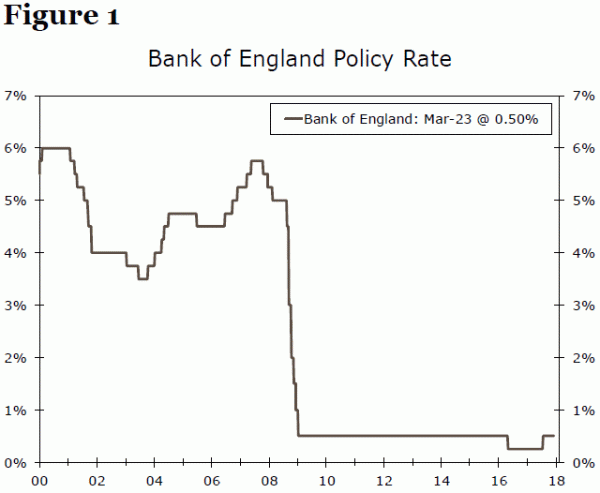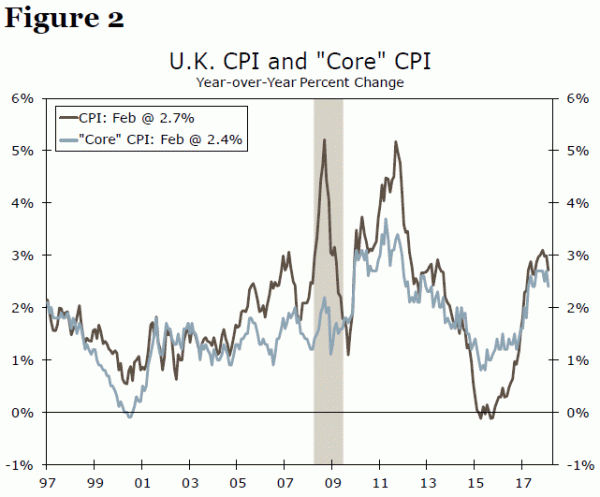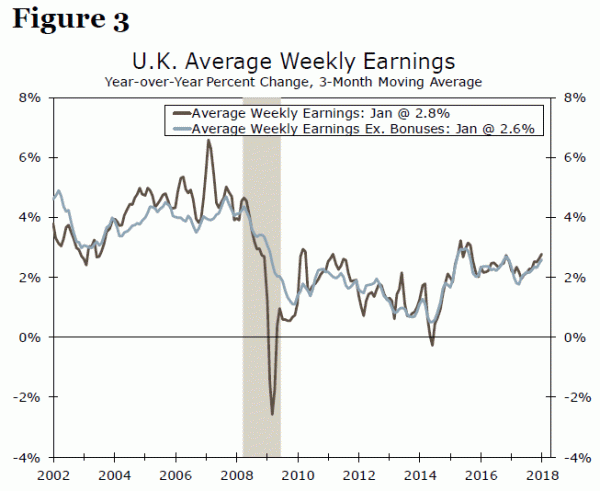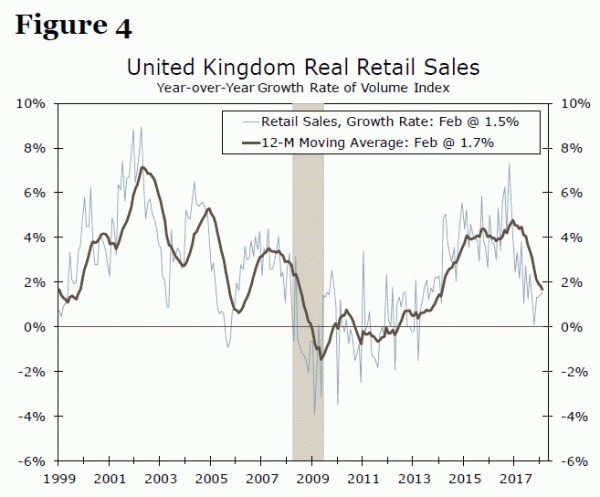CPI inflation in the United Kingdom fell from 3.0 percent in January to 2.7 percent in February, which could compel the Monetary Policy Committee (MPC) to remain on hold for the foreseeable future. But the labor market and the broader economy appear to be performing well, and the MPC has sounded more hawkish in the past month or so. We look for it to hike rates 25 bps at its next policy meeting on May 10.
The MPC at the Bank of England (BoE) decided at this week’s policy meeting to maintain its main policy rate at 0.50 percent, which was widely expected (Figure 1). The U.K. government mandates that the BoE hit an inflation target of 2 percent over the medium term. As shown in Figure 2, the overall rate of CPI inflation has exceeded 2 percent continuously over the past 12 months. The surge in CPI inflation last year reflects, at least in part, the sharp depreciation of the British pound in the aftermath of the Brexit referendum in June 2016. But sterling has stabilized over the past year, and CPI inflation is beginning to recede back toward target. Everything else equal, the MPC would want to remain on hold in coming months to watch the incoming price data.

 But everything else is not necessarily equal. Data released this week showed that the labor market is doing quite well at present. Specifically, payrolls rose by 168,000 between October and January, which was much stronger than most analysts had expected. The strong payrolls number helped to push the unemployment rate down to 4.3 percent, the lowest rate in 42 years. The strength in the labor market has caused earnings growth to trend higher in recent months (Figure 3). Higher earnings growth could raise unit labor costs, which could slow the return of CPI inflation to the BoE’s 2 percent target.
But everything else is not necessarily equal. Data released this week showed that the labor market is doing quite well at present. Specifically, payrolls rose by 168,000 between October and January, which was much stronger than most analysts had expected. The strong payrolls number helped to push the unemployment rate down to 4.3 percent, the lowest rate in 42 years. The strength in the labor market has caused earnings growth to trend higher in recent months (Figure 3). Higher earnings growth could raise unit labor costs, which could slow the return of CPI inflation to the BoE’s 2 percent target.
 Furthermore, it appears that the economy continues to expand at a reasonable rate in the first quarter. Data released two weeks ago showed that industrial production (IP) jumped 1.3 percent in January relative to the previous month. Although overall IP was pushed higher in January by a one-off surge in the mining and quarrying sector, output in the factory sector rose for the ninth consecutive month. In addition, real retail sales shot up 0.8 percent on a sequential basis in February, although the year-over-year rate of spending growth remains rather lackluster (Figure 4).
Furthermore, it appears that the economy continues to expand at a reasonable rate in the first quarter. Data released two weeks ago showed that industrial production (IP) jumped 1.3 percent in January relative to the previous month. Although overall IP was pushed higher in January by a one-off surge in the mining and quarrying sector, output in the factory sector rose for the ninth consecutive month. In addition, real retail sales shot up 0.8 percent on a sequential basis in February, although the year-over-year rate of spending growth remains rather lackluster (Figure 4).
 The MPC surprised market participants at its last policy meeting in early February when it said that “the UK economy has only a very limited degree of slack,” and that “monetary policy would need to be tightened somewhat earlier and by a somewhat greater extent over the forecast period” than previously anticipated. In its March policy statement the MPC reiterated its view that spare capacity will be used up by the end of next year. Although the MPC voted 7-2 to keep rates on hold this week, the two dissenting members of the committee presumably voted to hike rates.
The MPC surprised market participants at its last policy meeting in early February when it said that “the UK economy has only a very limited degree of slack,” and that “monetary policy would need to be tightened somewhat earlier and by a somewhat greater extent over the forecast period” than previously anticipated. In its March policy statement the MPC reiterated its view that spare capacity will be used up by the end of next year. Although the MPC voted 7-2 to keep rates on hold this week, the two dissenting members of the committee presumably voted to hike rates.
A few weeks ago we brought forward our expectation of another MPC rate hike, which we had originally penciled in for the August policy meeting, to May due to the more hawkish MPC rhetoric and the incoming data flow. We currently expect that the MPC will then remain on hold until early 2019, but we acknowledge that there is a reasonable probability that it could hike rates yet again later this year. As the MPC itself noted, a major uncertainty facing the U.K. economy remains the Brexit negotiations. If this uncertainty should start to weigh on growth later this year, then the MPC likely will remain on hold after its expected rate hike in May.












